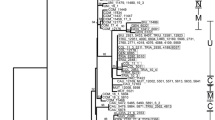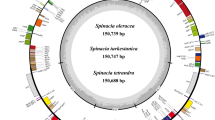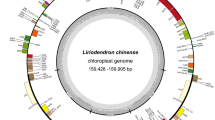Abstract
Diversity in the chloroplast genome of 171 accessions representing the Brassica ‘C’ (n = 9) genome, including domesticated and wild B. oleracea and nine inter-fertile related wild species, was investigated using six chloroplast SSR (microsatellite) markers. The lack of diversity detected among 105 cultivated and wild accessions of B. oleracea contrasted starkly with that found within its wild relatives. The vast majority of B. oleracea accessions shared a single haplotype, whereas as many as six haplotypes were detected in two wild species, B. villosa Biv. and B. cretica Lam.. The SSRs proved to be highly polymorphic across haplotypes, with calculated genetic diversity values (H) of 0.23–0.87. In total, 23 different haplotypes were detected in C genome species, with an additional five haplotypes detected in B. rapa L. (A genome n = 10) and another in B. nigra L. (B genome, n = 8). The low chloroplast diversity of B. oleracea is not suggestive of multiple domestication events. The predominant B. oleracea haplotype was also common in B. incana Ten. and present in low frequencies in B. villosa, B. macrocarpa Guss, B. rupestris Raf. and B. cretica. The chloroplast SSRs reveal a wealth of diversity within wild Brassica species that will facilitate further evolutionary and phylogeographic studies of this important crop genus.



Similar content being viewed by others
References
Abel S, Mollers C, Becker HC (2005) Development of synthetic Brassica napus lines for the analysis of “fixed heterosis” in allopolyploid plants. Euphytica 146:157–163
Avise JC (1994) Molecular markers, natural history and evolution. Chapman and Hall, New York
Chacon MI, Pickersgill B, Debouck DG (2005) Domestication patterns in common bean (Phaseolus vulgaris L.) and the origin of the Mesoamerican and Andean cultivated races. Theor Appl Genet 110:432–444
Garris AJ, Tai TH, Coburn J, Kresovich S, McCouch S (2005) Genetic structure and diversity in Oryza sativa L. Genetics 169:1631–1638
Geraci A, Chèvre A-M, Divaret I, Eber F, Raimondo FM (2004) Isozyme analysis of genetic diversity in wild Sicilian populations of Brassica sect Brassica in view of genetic resources management. Genet Resour Crop Evol l51:137–146
Gladis T, Hammer K (2001) Nomenclatural notes on the Brassica oleracea-group. Genet Resour Crop Evol 48:7–11
Gómez-Campo C (1999) Taxonomy. In: Biology of Brassica Coenospecies. Elsevier, Amsterdam
Gómez-Campo C, Prakash S (1999) Origin and domestication. In Biology of Brassica Coenospecies. Elsevier, Amsterdam
Harberd DJ (1976) Cytotaxonomic studies of Brassica and related genera. In: Vaughan JG, Macleod AJ, Jones BMG (eds) The biology and chemistry of the cruciferae. Academic, London
Inaba R, Nishio T (2002) Phylogenetic analysis of the Brassiceae based on the nucleotide sequences of the S-locus related gene SLR1. Theor Appl Genet 105:1159–1165
Kianian SF, Quiros CF (1992) Trait inheritance, fertility and genomic relationships of some n = 9 Brassica species. Genet Resour Crop Evol 39:165–175
Lannér C (1998) Relationships of wild Brassica species with chromosome number 2n = 18, based on the comparison of the DNA sequence of the chloroplast intergenic region between trnL (UAA) and trnF (GAA). Can J Bot 76:228–237
Lázaro A, Aguinagalde I (1998a) Genetic diversity in Brassica oleracea L. (Cruciferae) and wild relatives (2n = 18) using RAPD markers. Ann Bot 82:829–833
Lázaro A, Aguinagalde I (1998b) Genetic diversity in Brassica oleracea L. (Cruciferae) and wild relatives (2n = 18) using isozymes. Ann Bot 82:821–828
Lysak MA, Koch MA, Pecinka A, Schubert I (2005) Chromosome triplication found across the tribe Brassiceae. Gen Res 15:516–525
McCauley DE (1995) The use of chloroplast DNA polymorphism in studies of gene flow in plants. Trends Ecol Evol 10:198–202
Mitchell ND (1976) The status of Brassica oleracea L. subsp. oleracea (wild cabbage) in the British Isles. Watsonia 11:97–103
Molina-Cano JL, Russell JR, Moralejo MA, Escacena JL, Arias G, Powell W (2005) Chloroplast DNA microsatellite analysis supports a polyphyletic origin for barley. Theor Appl Genet 110:613–619
Nei M (1973) Analysis of gene diversity in subdivided populations. Proc Natl Acad Sci USA 70:3321–3323
Palmer JD, Shields CR, Cohen DB, Orton TJ (1983) Chloroplast DNA evolution and the origin of amphidiploid Brassica species. Theor Appl Genet 65:181–189
Panda S, Martín JP, Aguinagalde I (2003) Chloroplast and nuclear DNA studies in a few members of the Brassica oleracea L. group using PCR-RFLP and ISSR-PCR markers; a population genetic analysis. Theor Appl Genet 106:1122–1128
Parkin IAP, Sharpe AG, Keith DJ, Lydiate DJ (1995) Identification of the A and C genomes of amphidiploid Brassica napus oilseed rape. Genome 38:1122–1131
Provan J, Russell JR, Booth A, Powell W (1999a) Polymorphic simple sequence repeat primers for systematic and population studies in the genus Hordeum. Mol Ecol 8:505–511
Provan J, Soranzo N, Wilson NJ, Goldstein DB, Powell W (1999b) A low mutation rate for chloroplast microsatellites. Genetics 153:943–947
Provan J, Powell W, Hollingsworth PM (2001) Chloroplast microsatellites: new tools for studies in plant ecology and evolution. Trends Ecol Evol 16:142–147
Sharpe AG, Parkin IAP, Keith DJ, Lydiate DJ (1995) Frequent nonreciprocal translocations in the amphidiploid genome of oilseed rape (Brassica napus). Genome 38:1112–1121
Snogerup S, Gustafsson M, von Bothmer R (1990) Brassica sect. Brassica (Brassicaceae) I. Taxonomy and variation. Willdenowia 19:271–365
Song K, Osborn TC, Williams PH (1990) Brassica taxonomy based on nuclear restriction fragment length polymorphisms (RFLPs) 3. Genome relationships in Brassica and related genera and the origin of B. oleracea and B. rapa (syn. campestris). Theor Appl Genet 79:497–506
Song K, Tang K, Osborn T C (1993) Development of synthetic Brassica amphidiploids by reciprocal hybridization and comparison to natural amphidiploids . Theor Appl Genet 86:811–821
Tatout C, Warwick S, Lenoir A, Deragon J-M (1999) SINE insertions as clade markers for wild crucifer species. Mol Biol Evol 16:1614–1621
Thompson KF (1979) Cabbages, kales etc. Brassica oleracea (Cruciferae). In: Simmonds NW (ed) Evolution of crop plants, Longman Group, London
UN (1935) Genome analysis in Brassica with special reference to the experimental formation of B. napus and peculiar mode of fertilisation. Jap J Bot 7:389–452
Vendramin GG, Anzidei M, Madaghiele A, Sperisen C, Bucci G (2000) Chloroplast microsatellite analysis reveals the presence of population subdivision in Norway spruce (Picea abies K.). Genome 43:68–78
Warwick SI, Black LD (1991) Molecular systematics of Brassica and allied genera (subtribe Brassicinae, Brassiceae)—chloroplast genome and cytodeme congruence. Theor Appl Genet 82:81–92
Warwick SI, Francis A, La Fleche J (2000) Guide to the wild germplasm of brassica and allied crops (tribe Brassiceae, Brassicaceae), 2nd edn. http://www.Brassica.info/resources/crucifer_genetics/guidewild.htm
Wolfe KH, Li W-H, Sharp PM (1987) Rates of nucleotide substitution vary greatly among plant mitochondrial, chloroplast and nuclear DNAs. Proc Natl Acad Sci USA 84:9054–9058
Xu DH, Abe J, Gai JY, Shimamoto Y (2002) Diversity of chloroplast DNA SSRs in wild and cultivated soybeans; evidence for multiple origins of cultivated soybean. Theor Appl Genet 105:645–653
Acknowledgments
This work was funded by the UK Biotechnology & Biological Sciences Research Council and the Natural Environment Research Council. The authors would like to thank Dave Pink, Dave Astley and Graham Teakle for advice and provision of accessions and Neale Grant, Sandy McClement and Jason Pole for DNA extraction and plant husbandry.
Author information
Authors and Affiliations
Corresponding author
Additional information
Communicated by H. C. Becker.
Electronic supplementary material
Rights and permissions
About this article
Cite this article
Allender, C.J., Allainguillaume, J., Lynn, J. et al. Simple sequence repeats reveal uneven distribution of genetic diversity in chloroplast genomes of Brassica oleracea L. and (n = 9) wild relatives. Theor Appl Genet 114, 609–618 (2007). https://doi.org/10.1007/s00122-006-0461-5
Received:
Accepted:
Published:
Issue Date:
DOI: https://doi.org/10.1007/s00122-006-0461-5




